You can’t replace experience and judgment with lab tests and a computer simulation. But when you add lab tests to the experience and judgment and have an adult supervise the process, you might be able to get somewhere.
One of the more difficult questions regarding enclosures is can we insulate the interior of a mass wall in a cold climate without causing damage from freeze/thaw cycles? The answer is usually yes, we can insulate. But, and there is almost always a “but,” it depends. How we answer this question is based mostly on experience and judgment. We can backstop that experience and judgment with materials science and sometimes even a calculation.1
When we insulate a building, whatever is outside of the insulation gets colder in the winter. Quick, send out a press release. This is amazing news. Of course, this is only true if the building is heated. Keep this in mind for later. This is a not too subtle point.
If things get wet outside of the insulation, they tend to stay wet longer because there is not much energy available from the interior to dry the wet things. And, if they are wet, and it drops below freezing, bad things can happen. So the wetter things are, and the longer the things are wet, the bigger the risk if it drops below freezing.
It is not the freezing itself that is the issue; it is the water freezing in the material that is the issue. Of particular concern to us geeks are concrete, brick and stone materials. We have a pretty good handle on concrete, we are getting good with brick, and we are pretty pathetic with stone. Oh well. How hard can this be? Water freezing has been occurring for a long time. Surely, we understand it. Actually, no. We don’t really. Not in porous materials. Not very well at all.
On simple examination, most folks conclude that when water freezes it expands 9%, and, the expansion busts the material apart. Not quite. In porous materials the freezing point of water decreases as function of pore size, according to a long dead guy by the name of Lord Kelvin. This means that water contained in large pores tends to freeze but water in smaller pores does not necessarily. This is a huge complication that we will not get into beyond saying that not all of the water available for freezing necessarily freezes when it freezes. Got that?
Sometimes there is plenty of space for water to be held or for water to move to. Therefore, just because it all freezes, it might not cause a problem because there is space for stuff to happen. It gets more complicated when we consider hydrostatic pressures created by chemical potentials and vapor pressure differences between super-cooled water and ice. Suffice it to say that as ice forms it also displaces liquid water forcing it to flow through capillaries ahead of the freezing front exerting hydrostatic pressures, and it is these hydrostatic pressures that cause the damage. Or, so some of us think, maybe.2 Having tiny bubbles3 available for water to squirt into can be a pretty big deal to relieve hydrostatic pressure. Folks familiar with air-entrained concrete should be nodding their heads at this point.
We might not understand all of this, but we know enough about some of this to actually make things work. We are engineers after all. We don’t have to understand it all to come up with solutions and options. Besides, the real world lets us know pretty quickly if we get it right and is brutally honest with us when we get it wrong.
So, where are we in all of this? Easy, start with something fundamental. For freeze/thaw damage to occur you need water. No water, no problem. So control the water, and you control the problem. Not quite. Some brick is really bad, some brick is pretty bad, some brick is pretty good, and some brick is great.4 The good news in this is that most lousy brick is so lousy that it has already gone bad, so the question of insulation becomes almost moot. But be careful with this. Just because the brick is lousy does not mean there is a problem. If the brick does not get wet, it does not have a problem.
What makes for a good brick? There are lots of opin¬ions. I think a good brick is one that makes it difficult for water to enter, but once it enters, the brick redistributes the water quickly and the brick has lots of space for the water to be held. But I don’t want a brick that, when it makes it difficult for water to enter it, also makes it difficult for the water to leave. So although I don’t want much water to enter, I want it easy for water to leave. I want the brick to be able to do this with water in the liquid phase, the vapor phase and the adsorbed phase. I want the brick to be strong, but not too strong. I want the brick to look good, and I want it to be cheap, use readily available materials, and bond well with common mortars under a range of weather conditions. I want it to last almost forever. And, I want it to be easy to work with.
Wow, what a list. Through a lot of trial and error and a lot of time (hundreds of years), we have figured out how to make brick that meets all of these requirements. That is the good news. The bad news is that this is true for almost all new brick but not true for older brick. Older brick does not necessarily mean more than a hundred years old. It can mean 50-year-old brick and sometimes even 30-year-old brick.
How can we tell good brick from bad brick? For this freeze/thaw thing it turns out to be the critical degree of saturation (Scrit).5 Frost damage results in permanent irreversible expansion. However, there is a critical degree of saturation (Scrit) below which no frost damage occurs regardless of the number of freeze/thaw cycles the material is exposed to.6 We are not entirely sure why this is, but we are sure that this is. So we work with this. Again, I point out that we are engineers and this is what we do. We don’t always have to know why something is, only that it is, in fact, is.7
How do we determine this critical degree of saturation (Scrit)? Easy. Get a brick and wet it a little and cycle it through some freeze/thaw cycles. Then, wet it some more and do the same thing. Wet it even more, and keep doing it until the brick does not come back to its original dimension (Photograph 1 and Figure 1).
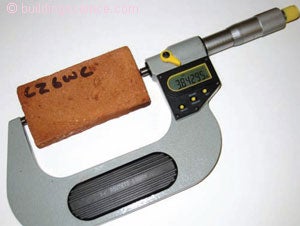
Photograph 1: Measuring Brick Expansion Under Freeze/Thaw Cycling—A micrometer is used to determine permanent irreversible expansion. The moisture content of the brick at which, under repeated freeze/thaw cycles, results in permanent irreversible expansion is called the “critical degree of saturation.”
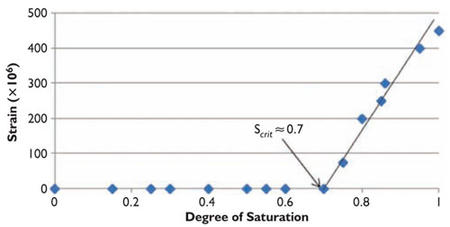
Figure 1: Critical Degree of Saturation—This is measured as a percentage of the vacuum saturation of the brick. From Mensinga, P. 2009. “Determining the Critical Degree of Saturation of Brick Using Frost Dilatometry.” Master of Applied Science in Civil Engineering Thesis, University of Waterloo, Waterloo, ON, Canada. This youngster is on to something here. Memo to self: keep an eye on him, he looks destined for great things.
What is a good Scrit? About 0.8 and higher. What is a poor Scrit? About 0.4 and lower. How do we know this? We measure “good” brick, which is brick that does not seem to be affected by freeze/thaw cycles even where it is exposed to severe wetting. Modern, frost-resistant brick yields these values. Then, we compare it to measurements of “bad” brick that is clearly affected by freeze/thaw cycles even where it is not exposed to much wetting at all.
Before we all run off jumping to conclusions, understand the following: there are a lot of buildings with bad brick that are working just fine. Huh? This is easy to understand. Remember what I said earlier. If the brick does not get wet it does not have a problem. Exposure counts for a lot folks. Not all multi-wythe brick assemblies are exposed to severe wetting or wetting severe enough to cause a problem even if Scrit is low.
Now that we know what a good brick is and what a bad brick is, maybe we can work with this key bit of material science knowledge. But we also need to use experience and judgment as well. Let’s go back to the original key question. Can we insulate the interior of a mass wall in a cold climate without causing damage from freeze/thaw cycles?
First, go to the building and look around very, very carefully. Look for brick that is damaged. What does damaged brick look like? Trust me, you will know when you see it. Check out these images (Photographs 2, 3 and 4) to help you “calibrate” your observations.
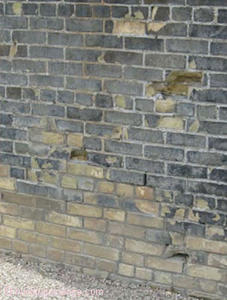
Photograph 2: “Classic” Freeze/Thaw Damage—Low to the ground, not very exposed to rainwater and in really bad shape. It turns out that this is a “bad” brick with a low Scrit.
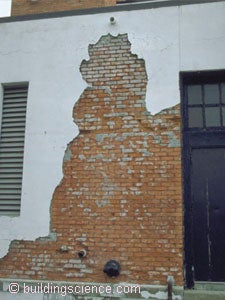
Photograph 3: Scupper—This is a no brainer. Don’t dump the roof water onto the wall. This is not an insulation problem. This is just dumb.
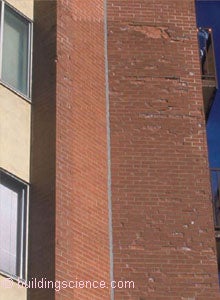
Photograph 4: Early ’80s Ontario Apartment—The brick is clearly experiencing freeze/thaw damage. It should not be doing this because the brick is not being exposed to what I would define as an extreme exposure. The brick turned out to be pretty bad when tested with an Scrit of less than 0.5, which is unusual for a 30-year-old brick. Most of us felt that by the ’80s we had figured out how to make good brick. Apparently, that’s not the case here.
Photograph 2 is an easy one. This is “classic” freeze/thaw damage. It is low to the ground, not very exposed to rainwater and in really bad shape. It turns out that this is a bad brick with a low Scrit used in a high exposure application. But I know that already just by looking at it. I don’t actually have to test this brick type to know what is going on. Now, for a little bit more information to make this really interesting, which is this wall assembly is unheated and has been for many years. It turns out that the damage began to occur when the assembly became unheated and abandoned. This is an “ah ha” moment, folks.
Think about it. This is an example of what would happen to this type of brick if it were in a heated building that was then well insulated on the inside. An unheated building is a very good approximation of a wall in a heated building that is well insulated on the interior.
Now for the corollary: if an old building with a multi-wythe brick mass wall has been unheated for a whole bunch of years and the brick is not damaged it will not get damaged, if you decide to insulate it on the inside and heat it. If you measure the Scrit, will it be high or low or in between? It could be any one of the possibilities. It could be bad low Scrit brick that never gets wet. Or it could be good high Scrit brick that does get wet. Or in between. It does not matter because the important test turns out to be the real-world observation that shows the building has been fine even though it has been unheated. So, do you measure the Scrit? Sure, it is nice to know if it has been a bad brick that has not been getting wet or vice versa. It’s good stuff to know so you can put it in the file to cover your butt. Why? Exposures might change, and you might want folks to know if that becomes a problem.
What if I have a heated building? Where do I look? Look for a part of the building that is unheated and exposed. Best place is a parapet (Figure 2). Parapets typically have the most extreme exposure to rainwater wetting, and they are unheated on their backside because they project above the roof. They also typically get wetted from underneath and inside due to the stack effect moving interior moisture laden air to the parapet. If a parapet has not been experiencing freeze/thaw damage, you can pretty much conclude that if you insulate the interior of the mass wall assembly you are not going to have a problem either.
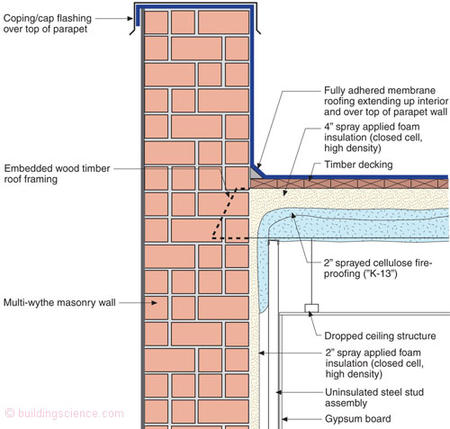
Figure 2: Parapets—Parapets typically have the most extreme exposure to rainwater wetting, and they are unheated on their backside because they project above the roof. They also typically get wetted from underneath and inside due to the stack effect moving interior moisture-laden air to the parapet. If a parapet has not been experiencing freeze/thaw damage, you can pretty much conclude that if you insulate the interior of the mass wall assembly you will not have a problem either.
Let’s look at Photograph 3. This is a no brainer. Don’t dump the roof water onto the wall. This is not an insulation problem, nor is it a brick problem: it would be hard to find a brick with an Scrit high enough to withstand this application. This is just dumb. Fix this. Then we can talk about insulation.
Photograph 4 is interesting for a couple of reasons. It is in Ontario, Canada, and it was built in the early ’80s. The brick is clearly experiencing freeze/thaw damage. It should not be doing this because the brick is not being exposed to what I would define as an extreme exposure. The brick turned out to be pretty bad when tested at an Scrit of less than 0.5, but it passed the ASTM C/B ratio requirement. This is unusual for a 30-year-old brick. Most of us felt that by the ‘80s we had figured out how to make good brick. Apparently, that’s not true in this case.
What do I do if I go check out the building, I don’t see any damage, the building is heated, and there are no exposed parapets? This is where the experience and judgment comes into play. You have to assess exposure and determine the resistance of the brick. The resistance of the brick you can test for. We have already covered that with the Scrit. Assessing exposure without any obvious visual clues is the trick. How much rain is hitting the wall? How much is absorbed by the brick (this is important to know to figure out whether the Scrit is going to be exceeded)? You also need to figure out the temperature of the assembly. A low Scrit is only a problem if it is exceeded under the “right type” of freezing conditions.
The two easy pieces of this are the absorbtion characteristics of the brick and the temperature profile. How much liquid water brick absorbs, and how quickly it absorbs it is called the capillary water uptake coefficient (the “A-value”) and it can be measured (Photograph 5). The temperature profile is pretty easy to predict with a computer simulation.
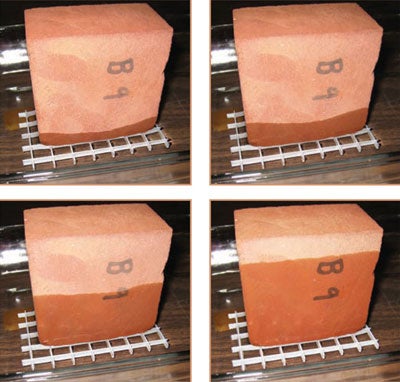
Photograph 5a (top left): Capillary water uptake coefficient after 30 seconds. Photograph 5b (top right): Capillary water uptake coefficient after two minutes. Photograph 5c (bottom left): Capillary water uptake coefficient after 10 minutes. Photograph 5d (bottom right): Capillary water uptake coefficient after 30 minutes.
The tough piece is figuring out how much rainwater actually hits the wall. You can’t use dynamic hygrothermal models to predict moisture conditions in mass walls without this key piece of information.
So what do you do? Ah, you guess. But it is an educated guess. Yup, at the end of the day, even though you can get the Scrit value, even though you can get the A-value, even though you can get the temperature profile and vary it with different insulation levels, you can’t get the moisture profile without knowing how much rainwater actually hits the wall. This is not as bleak as it sounds. You can do a sensitivity analysis. You bracket the problem by looking at what happens with a lot of rainwater on the wall, not quite so much rainwater on the wall, and a little amount of rainwater on the wall under varying levels of interior insulation. With the material properties in hand you can determine the level of risk.
At the end of the day, you must decide what an acceptable level of risk is and that requires judgment. Don’t go with a low Scrit brick in a high exposure, a well-insulated building in a cold climate. Don’t be thick as a brick.
Footnotes:
Most of you know how much I hate computer simulations, but every now and then they can be useful when the limits to their applicability are understood. This limited applicability is often the direct result of knowing the boundary conditions. The less established the boundary conditions, the less applicable the simulation. We often know so little about the boundary conditions that the simulation is almost useless. But sometimes we might know enough to help us bracket the problem and help us with the judgment part. The big unknown in most of this type of analysis is: how wet does the wall get from rain? Easy question. Difficult answer. It’s very difficult to predict in a building that has not yet been built. It’s much easier to answer in a building that has been around for a century. The building tells us, if we are smart enough to listen. That is why they call me the “house whisperer.” OK, the building doesn’t talk to us, but we often can tell by looking at it.
To really get into this, go to the masters of freeze/thaw. Start with Litvan, G.G. 1973. “Pore Structure and Frost Susceptibility of Building Materials.” Research Paper No. 584, National Research Council of Canada.
Almost all modern brick is great. In one of life’s many ironies, in days gone by we had great masons and lousy brick. Now we have great brick and lousy . . .
Scrit is the moisture content at which freeze/thaw damage begins to occur divided by the vacuum saturated moisture content. Damaged is defined as irreversible expansion. Although damage occurs after one cycle, six cycles are used to determine Scrit because a larger expansion is easier to measure, and six cycles are not enough to destroy the sample. Notice that I did not use the standard c/b ratio or the 50-cycle freeze/thaw test as a criteria. For reasons why they don’t work check out: Mensinga, P., J. Straube, J and C. Schumacher. 2010. “Assessing the Freeze-Thaw Resistance of Brick Masonry Units for Retrofit Insulation Projects.” ASHRAE Transactions, Volume 116, Part 2. You will have to wait until the ASHRAE Annual Conference later in the year to get it. I know the guys who wrote it, and so I know what is in it.
The two key papers on the subject are: Ritchie, T. 1968. “Factors Affecting Frost Damage to Clay Bricks.” Building Research Note No. 62, National Research Council of Canada; and Fagerlund, G. 1977. “The critical degree of saturation method of assessing the freeze/thaw resistance of concrete.” Materials and Structures 10:58.
This is referred to as “Clintonian Logic.” Don’t you miss him? It sure is boring without him.
